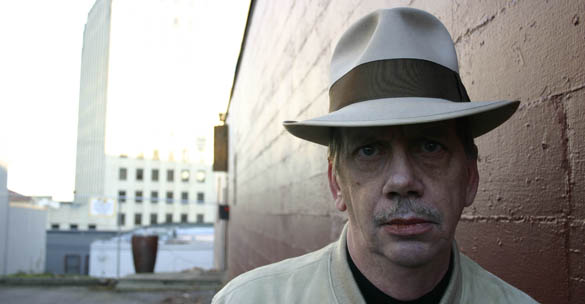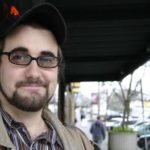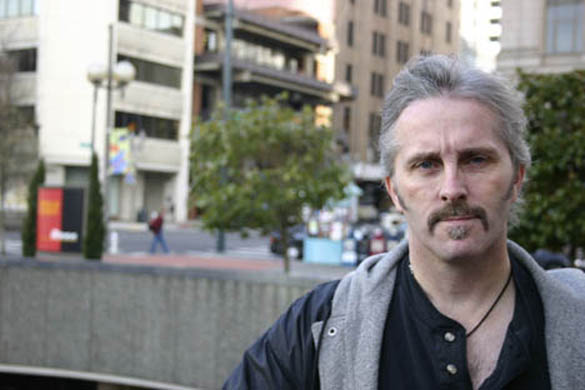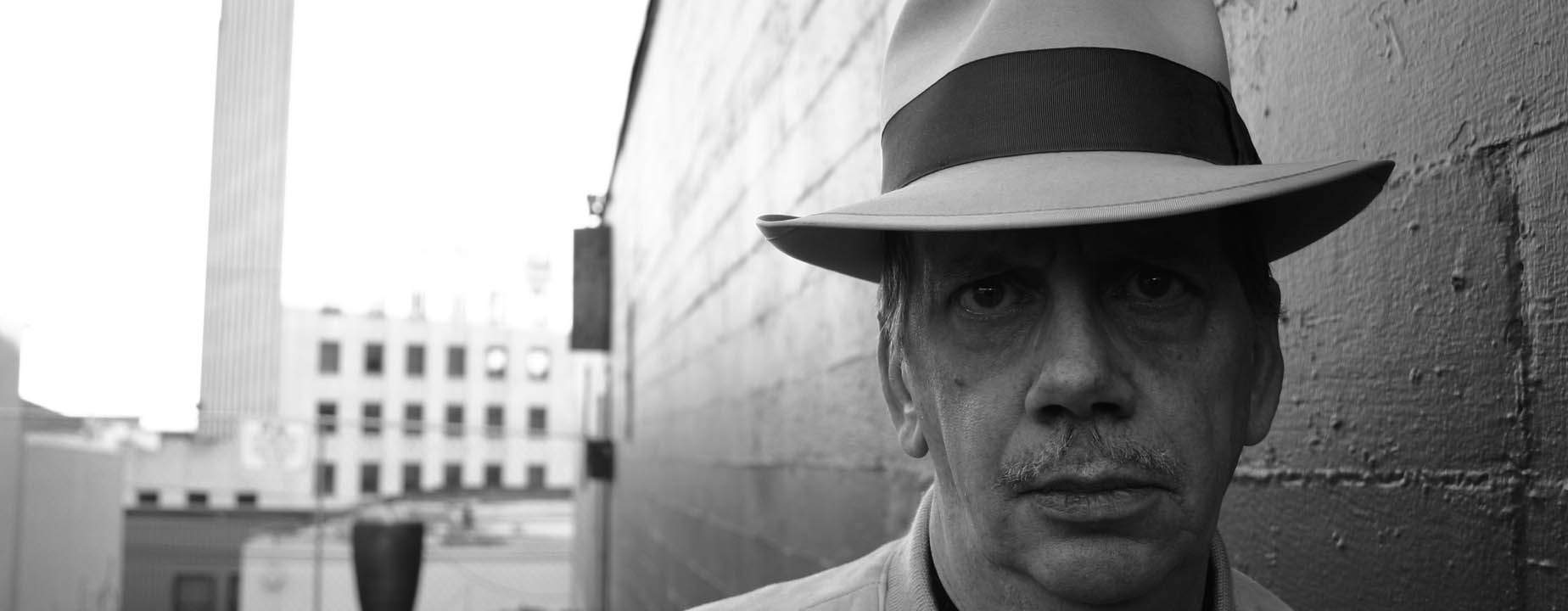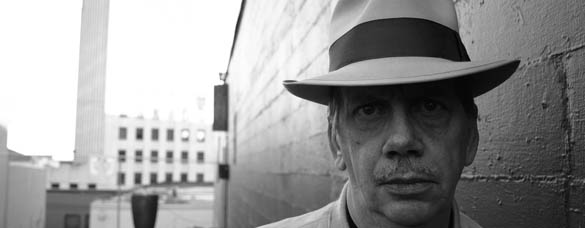UPDATE | FRI., JUNE 5 @ 4:50 P.M. — John Hathaway, the long-time Tacoma political cartoonist and publisher of The New Takhoman, passed away this week at the age of 69. Tacoma residents may recall Hathaway as a shadowy, chain-smoking figure who often sported a stylish fedora and vintage suit, and spoke in a rasp that was the result of too many cigarettes and glasses of scotch (they could also find him working as a bartender at Lincoln Bowl on Tacoma’s East Side).
“I try to get into the issues the big boys won’t touch,” Hathaway told me in 2007 for the article that appears below. At that time, Hathaway explained that he started The New Takhoman as a print publication in 1994 before moving it online in 2000. Three years later, he began to publish a daily cartoon that depicted three worms commenting on city politics. The worms — Izzy, Cockalvich, and Cohen — were named after his late father, Izzy Cockalvich Cohen, Hathaway told me. His biggest break as an online publisher came in the spring of 2003, when he reported on domestic violence allegations against then Tacoma Police Chief David Brame. A short time later, Brame murdered his wife and committed suicide. Suddenly, Hathaway and The New Takhoman were in the spotlight.
I spoke to Hathaway’s companion and significant other, Carolyn Perry, this afternoon to learn more about the circumstances of his death (UPDATE – TUES., JUNE 9 @ 12:45 P.M. | Mountain View Funeral Home in Lakewood confirmed Hathaway’s passing and plans for cremation). According to Perry, Hathaway died due to complications of severe emphysema and cirrhosis of the liver. “The scotch and the smoking got to him,” Perry told me. “Basically, his health had slowly declined since September. But he had quit drinking, so that was a plus.” Perry told me Hathaway died a little after 3 p.m. on Weds., June 3, at St. Joseph Medical Center in Tacoma. Hathaway was born on Aug. 15, 1945. Perry also told me his remains will be cremated. Although no formal memorial service has been planned at this point, Perry would like to host a celebration of Hathaway’s life with his friends and close associates in the near future.
To be sure, Hathaway had many enemies in local government. I doubt he cared. But there was also a grassroots group of local pundits, gadflies, and artists who admired him. I have worked at the Tacoma Daily Index for a little over a decade, and Hathaway would occasionally call me during that time to fill me in on stories he was working on and tips he had received. For some reason, he was always very kind to me. In turn, I was always grateful that I never did anything scandalous enough to warrant a mention in the pages of The New Takhoman.
In observance of his passing, I have decided to move the article I wrote in 2007 about Hathaway and his fellow political cartoonists to our newspaper’s Home page. Enjoy.


IF YOU SPEND time on the Tacoma Arts listserv or any of the local blogs, you probably know R.R. Anderson by his Photoshopped op-art.
Take the proposed wall at the Washington State History Museum. It was a controversial issue last year when the museum tried to build a wall to honor its donors; critics argued it would direct foot traffic toward the museum’s gift shop and box office, and away from an easily accessible pedestrian bridge linking the Thea Foss Waterway. In Anderson’s rendering, a wall was erected behind a tiny moat filled with snapping alligators, a spray-painted anarchy symbol, and scores of arrows directing visitors to “buy stuff!”
Earlier this month, Anderson launched a weekly series of hand-drawn political cartoons on Feed Tacoma, a Web site that collects posts from several local blogs into one online directory.
Though Anderson’s online presence is outsized, in person the tall, rail-thin 27-year-old Web designer is reticent. He speaks quietly and appears nervous as he twists his hands and shuffles his feet while seated inside a downtown coffee shop for an interview last week.
“My online persona is definitely a bit more annoying and obnoxious,” he says. “It’s just me having fun.” He knows he’s pushed some buttons with his designs, but he says he’s thick-skinned. “Originally, there was outrage,” he recalls, referring to the history museum rendering. “It was like, ‘How dare somebody do this to a fine institution that is trying to make things better?’ But now that people are getting a feel for who I am, it’s different. I’ve gotten feedback. People are definitely looking at my stuff. Some people tell me, ‘That’s awesome.’ I think other people are just ignoring me.”
And besides, Anderson asks, if he doesn’t produce editorial cartoons or op-art, who else will?
He has a point.
In Seattle, where two daily newspapers — The Seattle Times and Seattle Post-Intelligencer — have full-time political cartoonists (the latter boasts the Pulitzer-winning David Horsey), political cartoonists are part of a media landscape.
In Tacoma, not so much.
The News Tribune hasn’t had a political cartoonist since 1995, when Chris Britt left to join The Seattle Times.
“The state of newspaper cartooning nationally is not a happy one,” says David Seago, editorial page editor at The News Tribune. He says when Britt left, The Trib tried to find a new cartoonist. It advertised nationally and interviewed a number of candidates. “Eventually, however, the publisher at the time decided the full-time-employee was more badly needed in the newsroom,” Seago explains. Since then, the paper hasn’t made any efforts to hire a staff cartoonist.
“I, of course, would love to have a local cartoonist,” Seago adds. “But across the industry, a staff cartoonist is increasingly viewed as a luxury mid-sized newspapers — and even some metro dailies — cannot afford.”
Today, The Trib relies on a small roster of nationally syndicated cartoonists.
“POLITICAL CARTOONISTS ARE a dying breed,” says Stuart Neiman, a Hilltop resident whose illustrations appear in Tacoma Weekly. Neiman, 47, is a political cartoonist in the term’s classic sense: whereas Anderson’s designs and illustrations are Web-only, Neiman’s drawings appear in print on the Weekly‘s editorial page.
Neiman, a retired armed forces veteran, started drawing political cartoons in 2003. It was an outlet for a long, complicated lawsuit with Bates Technical College over termination of employment (the case was recently settled). “It was a positive way of voicing my aggravation to these things,” he explains. “People were telling me, ‘You have the skills and you have a bit of an attitude about things, and you have always had somewhat of a sarcastic look at life. You should start doing this.'”
So Neiman drew political cartoons on paper, scanned them into a computer, and posted them on his Web site — Tacoma Trashcan. Since then, he has turned three bedrooms of his Hilltop home into design studios. Though it wasn’t his first entree into art (Neiman holds a masters degree in Fine Arts from the University of Washington), it was a different style of illustration.
“It’s been by far the toughest thing to do creatively,” he says. The challenge comes in trying not to be so literal with his cartoons. A one- or two-panel image that quickly sends a message and “pops” off the page is what Neiman shoots for.
“In essence, political cartooning really comes down to trying to tell a story,” he explains. “A lot of times I kind of relate to a stand-up comedian. You’re making statements or telling a story. But you are really taking some of the things and really stretching and doing parody and satire. That means you are creating your actors, moving them, and making them do things. What I try to do with my artwork is not take the literal acts that are happening, but just take the basic premise of something and then stretch it.”
In February 2006, Neiman says he was ready to approach Tacoma Weekly about publishing his cartoons when a staffer came across his Web site and contacted him. Since then, Neiman has maintained an informal relationship with the paper: he draws up to three pictures a week, scans and posts them to his Web site, and the Weekly picks one to include in its paper.
“It’s become something that I use to keep myself focused and producing,” he says.
Neiman’s targets range from the local (Tacoma City Council, pot holes, the municipal budget) to the national (President George W. Bush is a favorite target). And he’s been surprised by the feedback from his targets.
“A few times, I have hoped that people would get mad,” he explains. “But they actually like it and ask for a copy of it. It takes some of the fun out of it. ‘I’ve got you in a tutu, and you want a copy of it?'”
“I TRY TO get into the issues the big boys won’t touch,” says political cartoonist John Hathaway, 61, who posts local government gossip, news, and editorial cartoons each weekday. The comic stems from a print-edition of The New Takhoman, which ran between 1994 and 1999. In 2000, Hathaway moved to the Web, and, three years later, launched his trademark cartoon: three worms commenting on city politics. The worms — Izzy, Cockalvich, and Cohen — are named after his late father, Izzy Cockalvich Cohen.
Though his Web site also includes written editorials and commentary, he says he leans more toward cartoons because of their quick, punchy style.
“I still enjoy writing articles,” he says. “It’s not that I’m lazy. It’s just that I’ve found that people’s attention spans are not that great. If you can say something to them in a cartoon, they get the picture. They get the point. An actual news story over 600 to 800 words, the attention span just isn’t there.”
He also counts himself a fan of fellow cartoonists Anderson and Neiman.
“Stuart is one hell of an artist,” he says. When Neiman drew a caricature of Hathaway, Hathaway’s girlfriend had it framed. And he reprinted Anderson’s first cartoon on The New Takhoman Web site. “The more the merrier,” he says. “Welcome to the club.”
FOR ANDERSON, WHO is new to political cartoons, his drawings are an extension of a long history of creativity. As a young person growing up in Juneau, Alaska, he was always into drawing and animation, but the small town offered no outlet. In the late-1990s, he moved to Sunnyvale, Calif., and attended Cogswell Technical College, where he majored in computer animation. In 2001, he moved to Tacoma and was soon hired by a graphic design company downtown. He collects his art online at Holistic Forgeworks. The name comes from an imaginary company he created in high school so he could receive resampled crucibles from trade magazines.
Today, Anderson lives in an apartment near Wright Park. He typically spends Saturday afternoons drawing a new cartoon for the week ahead. Once finished, the image is scanned to be loaded onto the Feed Tacoma Web site.
“I’m kind of like an underground editorial cartoonist,” he says. “I don’t have an editor saying, ‘You can’t do this.’
“I’d like to keep [the cartoons] local,” he adds. “The whole thing at first was that nobody has a voice for cartoonists in town. I would like to keep it local. When hot-button issues come up, I would like to be the elephant in the room.”
UPDATE | TUES., JUNE 9 @ 10 A.M. — The Tacoma Daily Index recently dusted off this article and interview with Hathaway that was discovered in our archives. At the time, he was running for a seat on Tacoma City Council (he later withdrew his bid). The article does not show up in our archives online, but is reposted here. Enjoy.
A shadowy, perennial outsider eyes a seat inside City Hall
Tacoma Daily Index (Feb. 8, 2007)
By Todd Matthews, Editor
John Hathaway is a shadowy presence in Tacoma. Typically clad in a fedora and vintage suits, Hathaway is a former Lincoln Bowl bartender who views the city through a lens that recalls an earlier age of gritty noir, dive bars, AM radio, and reporters on the QT.
As of last week, Hathaway is also a candidate for Tacoma City Council — specifically, he’s aiming for an at-large seat presently held by Councilmember Julie Anderson.
Before you dismiss Hathaway, 61, as a fringe outside candidate, he wants you to know this: he was born and raised in Tacoma, and graduated from Lincoln High School; his Web site, The New Takhoman (thenewtakhoman.com), regularly posts gossip and news on the city from tipsters inside City Hall; and it was Hathaway who first started digging into domestic violence allegations against former police chief David Brame, who murdered his wife, Crystal, before committing suicide, on April 26, 2003 (Hathaway is a major subject in the book Tacoma Confidential, by Paul Larosa, and a feature about the case on an episode of the CBS television newsmagazine 48 Hours).
“My life is no longer private,” observed Hathaway recently, as he settled into a couch at Blackwater Cafe in Tacoma to discuss his views on the city and his bid for City Hall.
TACOMA DAILY INDEX: Why run for City Council?
JOHN HATHAWAY: I’ve been observing council meetings for almost the last 15 years. Your average Tacoma citizen really doesn’t have a voice. I don’t have the solution to get people involved in city politics. But 48 percent of people in Tacoma, last I heard, were poverty level or below. There is a group of people trying to put food in their mouths to survive. Then you have your so-called middle-class — your husband and wife, both work two jobs, have 2.7 kids, the average American family. They’re taking their kids to soccer, ice skating, ballet, all the kids stuff. Working long hours to take care of the house. They don’t have a voice in politics. It might sound crazy, but those are the people I want to represent. Not the people already involved. I don’t have the answers, but I want to figure out somehow get those people involved in local government, to give them a voice. So I decided, ‘Let’s throw our hat in the ring and see what happens.’
INDEX: You are mostly known through your Web site The New Takhoman. How long have you followed city issues, and how did that Web site come about?
HATHAWAY: I was working for a guy named Bob Lane. [He] used to be a police beat reporter for the Trib. I just started hanging out with him. He was afraid to print the stuff that I wanted to write. It was Bob Lane’s idea that I start my own publication because he was afraid he would get sued for the stuff I did. I’ve never been sued. He and I put out the first edition of The New Takhoman. Until 1998, it was an 81/2 by 11 broadsheet. The first edition was one page with not much on it. I think the biggest one was maybe four pages. I was reporting on stuff that the Trib just didn’t want to get into.
INDEX: What’s your aim with The New Takhoman?
HATHAWAY: First of all, to try and get into the issues that the big boys won’t touch. A lot of it is, yes, satire. Some people might say I’m picking on people. It’s just a way of saying, ‘Hey, look what we’ve got.’ In my opinion, democracy is the best system we have, but it just doesn’t always work right. So let’s just start pointing out here and there where things might be improved. That’s what I’m doing.
INDEX: Do you see a connection between what you do with The New Takhoman, and what you could do if elected to City Council?
HATHAWAY: Yes. Definitely. One of the problems with the councils that I have seen — I’m not just talking about the current council — but the only councilmember I’ve known to get involved in stuff like this, and I’m talking 1994 or 1995, was Dave DeForest. Dave would ask questions. His biggest downfall was that he would ask the questions, but he would never follow up on them. I see City staff has the tendency of not wanting to answer questions for some reason. If I was on the council and asked a question, and I didn’t get the answer the following week, then I would ask my next question, and ask for my answer to the last question until I get it. I think the citizenry deserves answers. I think we’ve been obfuscated. Councilmembers really aren’t fully informed. I think you have to have answers. The current council doesn’t ask questions.
INDEX: In my mind, you are an outsider — not a traditional candidate. Would you agree with that?
HATHAWAY: Yes. I’ve been called the anti-candidate. I think people in politics, even in Tacoma, run for personal gain. I’m not running for personal gain. I could retire. But that’s just not my nature. I’ve been asked, ‘Well, why would you do it?’ My translation: ‘Why are you running for City Council?’ Well, I’m not out to change the world. I’m just out to have a little fun. If I can have a little bit of fun and make a modicum of difference, well . . . . People just become entrenched in what they are doing. When you become entrenched, you have a tendency to put blinders on.
INDEX: What are some of the things that you would like to tackle if you were elected to City Council?
HATHAWAY: I would love to see better communication between the council and staff. I would love to see the council get ahead of issues, rather than getting stuck with issues. And I would definitely like to see a change in the council rules. The current council, and other councils, on issues they have always talked about a fair playing field. Currently, I don’t think Tacoma has a level playing field. When citizens have gripes, they should be able to voice them — simple as that — without being gaveled down for getting out of line. I think it’s time we get people on the local council that might be a little thicker-skinned, and won’t take things so personally.
INDEX: What has been the response to your announcement to run for City Council?
HATHAWAY: One person who works for the City, and I won’t name them, said, ‘John, you’re not going to get much support, but you’re going to get a lot of votes.’ That means I’m not going to get the good-old-boys support. I might get inside support from some people, but I’m not going to get public support. I have had a lot of people willing to put out a hand to help.
INDEX: It seems that you are so much of an outsider at City Hall, if you were on City Council, would you be accepted? How much would you shake things up?
HATHAWAY: I’m not worried about being accepted or not accepted. I’m sure some people on City Council would say, ‘Well, now that you are elected to council, you can’t do The New Takhoman anymore.’ That’s not going to happen. If I was such an outsider at City Hall, how do I get the information I get. It’s amazing. It’s amazing.
INDEX: Do you feel like this city is your hometown? Do you care about the city, or have a connection to it?
HATHAWAY: When I was being interviewed by 48 Hours, Paul Larosa asked the same question. I believe my answer was, ‘This is my town.’ Yes, this is my town. Hell, yes! This is my town. I made a conscientious decision a long time ago: rather than taking the normal route of speaking at citizens’ forums at City Council meetings, I started The New Takhoman. I think I can say more in The New Takhoman than I can ever get away with in front of City Council because I get gaveled down. Councils do not like to hear bad news. They do not like to hear naysayers. The people deserve a voice. Since Dave DeForest, I don’t think they have had that voice. I could be dead wrong, but that’s what it seems to me.
INDEX: The New Takhoman has a gritty, hard-boiled detective feel to it.
HATHAWAY: My alter-ego is Paul Malone, hard-boiled detective, on purpose.
INDEX: Do you still see Tacoma as a gritty city?
HATHAWAY: After having worked at Lincoln Lanes for six years off and on. After having gone to places like that — a lot of them are gone now. Tacoma isn’t necessarily gritty, but it’s a blue-collar city. Yet, the elected officials, they just don’t want to admit it. If we could have squeezed another museum in, they would have done it. I guess that’s what I’m trying to say. Look around. Do you think these people can afford to go to those museums? Stop and think about it. Tacoma is still a working-class town, for the most part. The City is trying to create an image. Why don’t we stick with what we are, and work on that?
– – – – – – – – – –
UPDATE | TUES., JUNE 9 @ 1:30 P.M. — CBS News ’48 Hours’ Producer Paul LaRosa has written an article about Hathaway’s death here.
– – – – – – – – – –
UPDATE | WEDS., JUNE 10 @ 7:40 A.M. — Tacoma political cartoonist R. R. Anderson has drawn his weekly Tacomic to mark Hathaway’s death. The cartoon is online here.
– – – – – – – – – –
Todd Matthews is editor of the Tacoma Daily Index, an award-winning journalist, and author of A Reporter At Large and Wah Mee. His journalism is collected online at wahmee.com.
